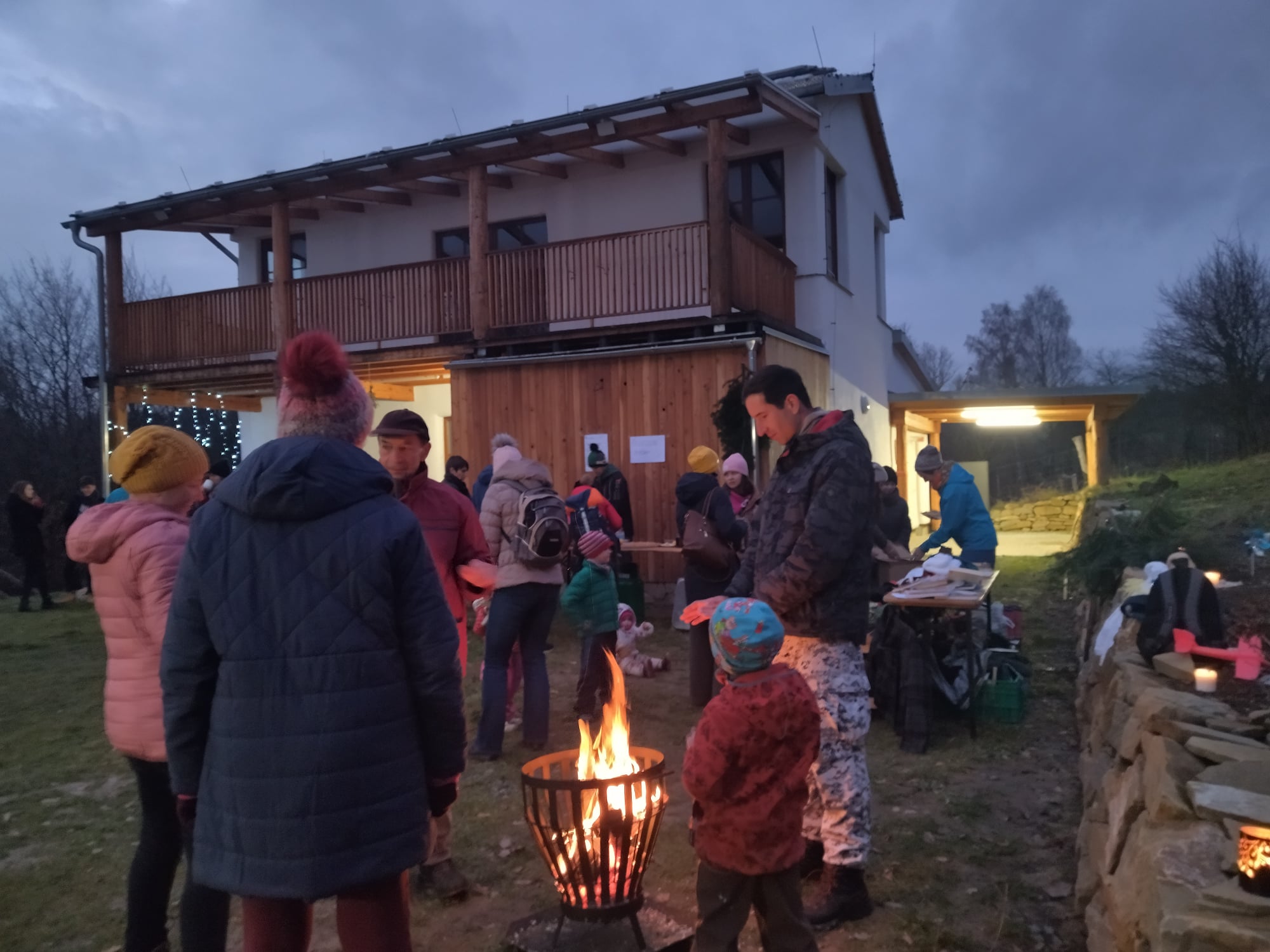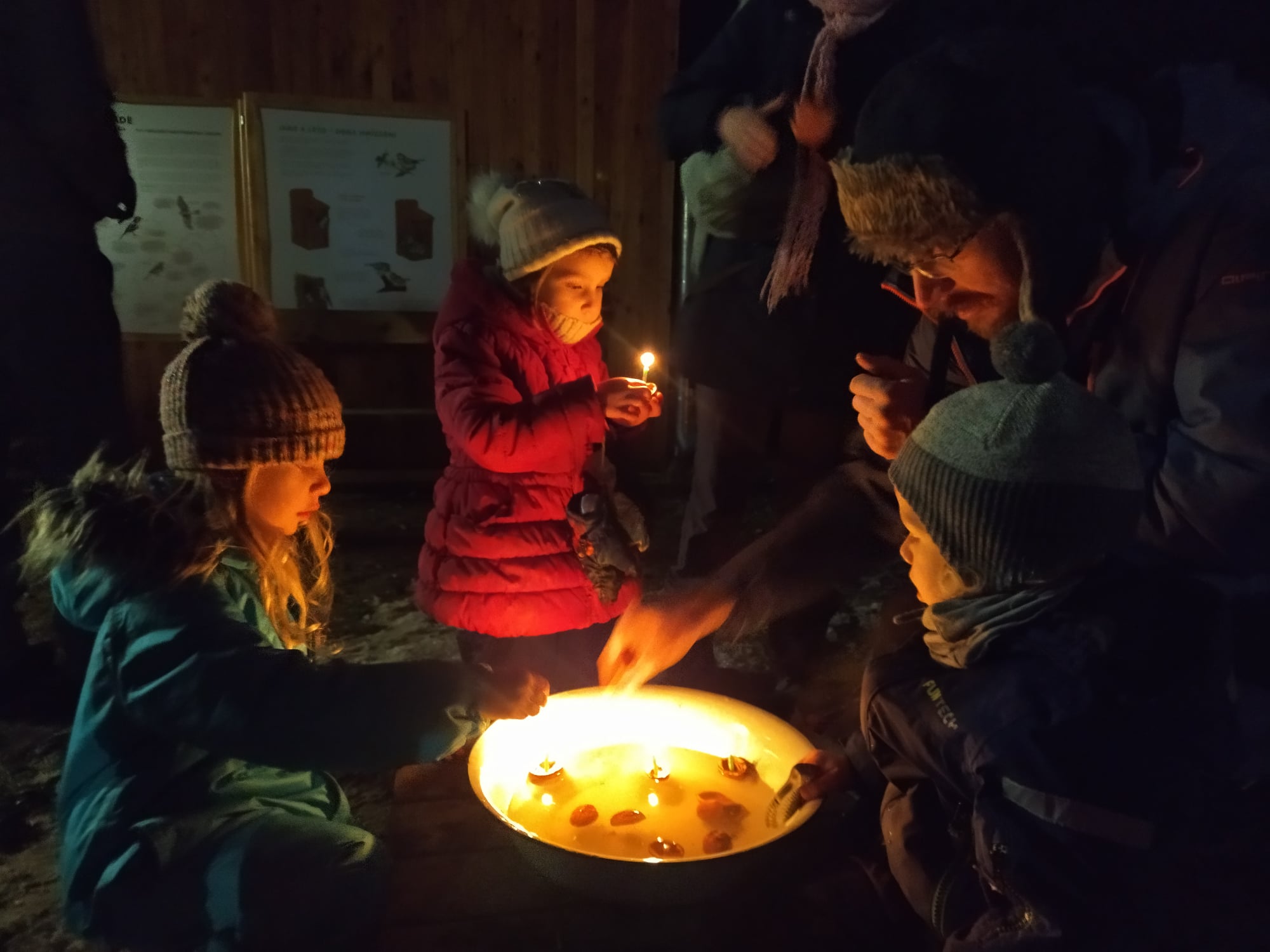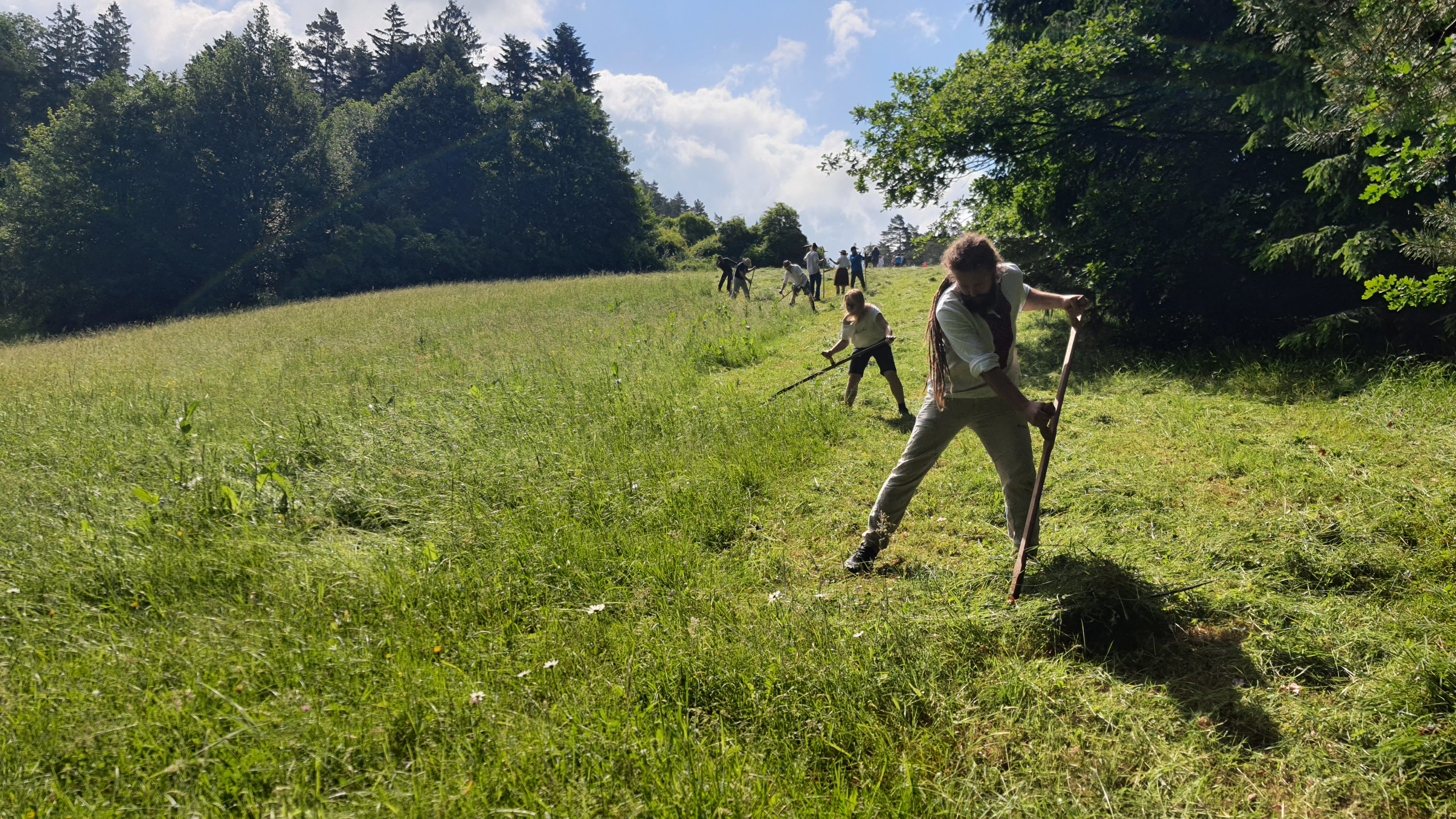In the Živel Zlín project, we focus on raising awareness of sustainability in the Zlín Region. We draw from folk traditions and bring people closer to the environmental and social aspects of a sustainable society. We emphasize intergenerational sharing, pulling people out of their social bubbles and mediating environmental awareness gently through culture and community encounters.
Živel is an association focusing on raising awareness of sustainability in the Zlín Region. We draw not only from folk traditions and bring people closer to the environmental and social aspects of a sustainable society. This year we will organize the third year of the meadow mowing event and also we organized the community event Velíková caroling for the first time. We are two friends who worked together as scout leaders for many years and now, after graduating from university and living in different countries, we have returned to our hometown. Unfortunately, this city, which used to be a center of innovation, where the Baťa company was born, became an extinct city after communism, without any civic initiatives and cultural or environmental activities, not to mention. So we try to bring life to our birthplace and focus on the issues that we find very urgent, namely social and environmental sustainability. As a strategy, we chose to reach the locals through culture, tradition, and folklore. This region is very traditionally rooted in the Czech Republic and we try to show the locals that innovation can build on the knowledge that locals have known for centuries and that the word community is not synonymous with communism, but a human need and a great way to effectively implement common goals. We cooperate with local organizations such as the cultural organization Zvěřinec or the eco-center Na Pasece Velíková, which have similar goals and we support each other because in cooperation we have much more potential. As we currently cover events entirely from our own resources, we would like to have a larger scope, however, we also try to zero waste and secure the event within the community by redistributing competencies at our events.
Please highlight how the project can be exemplary in this context
In our project, we focus primarily on sustainability through community activities. In the community meadow mowing project, we organized a cultural community event to support the species diversity of local meadows. Species diversity of meadows is achieved by manual mowing, which is gentle on the plant cycle, it is also important timing that the plants, for example, have space to sow. This method of meadow care has been used traditionally and in the region. During communism, however, there was centralization and industrialization, which did not take into account species-rare localities. The traditional way of caring for meadows is remembered by the oldest generation. Local seniors were very excited to share their experience with hand-mowing, an activity that requires a series of difficult procedures. The event was open to the general public and to our delight, people from completely different backgrounds gathered here. The meadow was located at the border of three villages, so it connected the locals from these localities. The event was attended by folklore fans, parents with children from a nearby forest nursery, local seniors and students. Most of the participants did not know each other and it was a beautiful intergenerational sharing. The way the event was organized was also a sustainable component. Due to the outdoor nature of the event, we did not need facilities. We borrow the tools needed for mowing, partly from locals and partly from an environmental organization that focuses on mowing meadows. The selected locality is in the care of the local agricultural center, which allowed us to adjust this part manually. The hay that remained after the mowing was then used by the agricultural center for its needs, probably for feeding. The event was accompanied by music, some participants wore traditional costumes and participants were also invited to bring refreshments. The Velikovske caroling event was held in a similar spirit.
Please highlight how the project can be exemplary in this context
In our project, we emphasize awareness through experience and sharing. We believe that a positive attitude and examples can reach target groups more easily than blackmail by fear. What's special about our project is that we use culture, music, tradition and joy as an essential part of the educational experience. At our events, we like to use some kind of intermediate step that will help bring people closer to the issue. Community and social belonging is key factor in our events. Some people come because of the environmental dimension of these events, but some people only come because they like the cultural part or the folk part or they just like to meet people, and when it all comes together, we suddenly see that we have a lot of things in common, even though everyone prefers something different in their lives and that's fine. At the same time, it's a great way to provide new information to people who wouldn't reach it in another social bubble or community. People from various groups came to our Velíková Caroling event, we sang, feasted together, locals that no one knew came, as well as people from the wider area. The program included a "path of courage", which was located in the adjacent forest. People were able to go through it during the program and try out various traditional activities, which, however, also reflected some environmental considerations and enlightenment. The event was very natural and positive. There was a lot of participation and we are already looking forward to the next year.
Please highlight how the project can be exemplary in this context
In the Živel project, we place great emphasis on inclusion. We have been thinking about how we can bring this environmental project closer to people who are not interested in environmental issues, are not close to it, do not move into the so-called bubbles, where the topic of environmental protection and sustainability is part of the lifestyle. Although our regional city practically lacks any organization that would have long been dedicated to environmental education, for example, this issue tends to appeal to younger generations, who have better access to a variety of information. We have decided that our goal will not be to address those already addressed but to focus on the inclusion of older generations. We want to address not only young people with families with children but also age groups for whom the topic of environmental care can be perceived as a fad of today. The region of Wallachia, where our city is located, is characterized by the preservation of traditions that are not only linked to culture but are also intertwined with the care of the landscape. We want to show the locals that sustainable care for the landscape, but also togetherness and active participation, is something that is their own, that they know well and that concerns them. We want generations to be able to learn from each other. In our project, we use the culture and community activities that we offer to the general public.
Please highlight how this approach can be exemplary
I consider that our project is responding to several needs of local people. It is mainly a restoration of the community, a joint action to protect the landscape, the transfer of cultural heritage to future generations, the protection of environmentally valuable sites.
We try to address the locals non-violently and gently, using the traditions that the locals know. Overall, we realized that people in Zlín react quite negatively to unknown things, on the contrary, they tend more to safe and repetitive things (in contrast to larger cities). We hold our events in harmony with nature, with attention to zero waste, accessibility - free entry, refreshments and a community-provided program. We address the general public and emphasize more excluded social groups such as the older generation or foreigners. In the future, we would also like to invite more foreigners residing in this region. Participating in a traditional community event can not only be an interesting experience for them, but it can also be beneficial for the perception of foreigners by locals. We are also glad that even though we are two women as organizers, our events have so far been very gender-balanced.
The project involves the physical transformation of a place that shows how regenerating the environment and restoring biodiversity can be a cultural experience connecting generations and social bubbles. Specifically, it is about for example caring for rare meadows through community cultural events. We managed to preserve species diversity in these places, to provide awareness about this type of nature protection, to pass on the skills associated with it from the older generation to the younger, to involve various stakeholders from the region in environmental protection. At the same time, through the Velíková Caroling event, we managed to reach the general public, which now has a better awareness of local nature protection. The transformation of the place, which is located on the border of the periphery of the regional city (where the village used to be) and two neighboring villages, is a good opportunity to restore broken ties between individual settlements, which in recent years have focused more on the city center. It is a place where people often walk on their nature trips, as it connects individual hiking trails. Through active care of adjacent sites, locals can gain a greater sense of belonging to the environment they inhabit. Pay attention to which places are more disturbed, eg by pollution, and require more attention and care. Community care for the landscape is also something that evokes in people a sense of belonging not only to nature but to each other. The combination of sustainability and local traditions and folklore proved to be a great tool for inviting people who were not primarily interested in this issue to environmental projects. In our project, we focus on the urgency with which it is necessary to approach this issue and the effort to address the general public.
Please also explain the benefits that derived from their involvement.
During our events, we addressed the general public. Our goal was to get people who are not normally interested in environmental and sustainability issues. As the topic of these events, we have chosen events that have the potential to reach the general public and do not target the political, religious or economic focus of the participants. In the Wallachian region, there has been an effort in recent years to preserve traditions and care for the landscape, and it is very interesting for people to learn how people lived in the region, for example, 100 years ago. Our event is therefore culturally focused but with an overlap into sustainability. We do not hide this fact and it is communicated. However, people often do not even know what to imagine under environmental issues, so they do not mind this element. The benefits of this approach are that we are succeeding in raising awareness about sustainability in a non-violent way to the general public. We have no limit on who can attend the event. The events were free and people could participate as they saw fit.
In our project, we focus on global challenges such as climate change or chaos, but also social issues such as generational and gender inequality. Instead of using the structure of, for example, an international non-profit organization that addresses these global challenges, we have decided to set up our own, which will be based directly on the conditions in which the locals find themselves. In particular, climate change, for example, will not affect the same everywhere on the planet. Somewhere there will be floods, somewhere they will have drought, elsewhere both. Local targeting is essential in communicating this problem locally. We try to awaken in people a sense of belonging to the environment in which they find themselves, through tradition, getting to know their surroundings, learning to read in the landscape. We would like to convey to people the awareness that man's care for the landscape is his own and is a vital part of life. In nature generations of our ancestors were looking not only for a livelihood but also for cultural, spiritual, and community fulfillment, which correspond to the pillars of today's modern concept of sustainability.
In the Živel project, we approach sustainability in an innovative way that is unparalleled, at least in the Czech Republic. The uniqueness lies primarily in the fact that we find effective ways to reach target groups who are not aware of the concept of sustainability. For example, environmental projects are aimed primarily at children and young people, or students or young families. We raise young children to protect the environment and ecology. They then have the task of coming home and convincing their parents, for example, to change their habits and attitudes. Which, in our opinion, is neither efficient nor fair. These children may grow into a responsible generation, but the issue of sustainable development needs to be addressed now at all levels, with people in productive age, but also, last but not least, with people of retirement age who are not only major consumers but also largely active citizens who have a major influence for example on the election results. We can already target these generations through folklore and traditions, and in the future we would like to expand this activity to active work with people of retirement age, trying to restore their empowerment and sense of belonging. It depends on the state in which we leave the planet to future generations. We also link the aspect of social and environmental sustainability by emphasizing cultural activities in the region and community gatherings.
Please provide clear documentation, communication of methodology and principles in this context.
Our project is characterized by intergenerational sharing. However, we try to cooperate with other organizations, so they also have the opportunity to expand their target group by different generations and various so-called social bubbles. For example, our neighborhood caroling event took place in the backyard of the eco-center, which is located on the outskirts of the city of Zlín. The new eco-center is just beginning its activity and is currently only connected to the activities of the forest nursery located next door. Thanks to our event, people from the area came and had the opportunity to see the eco-center and the forest nursery, which they often have distorted ideas about or are not interested in. We, therefore, succeed in sharing our method of breaking up social bubbles outside of our activities. We would like to continue this initiative. We establish relationships with the local university so that these young people can also communicate their visions and needs to other generations and vice versa. People can learn from us through social media such as the Živel Facebook page, Instagram, or through our partner organizations. We are also preparing a website. However, we have found that in this region rather than the media works word of mouth, when a friend invites a friend or family. Overall, people are more skeptical about new initiatives. We actively establish relations with local organizations such as Ekocentrum na Pasece Velíková, forest nursery in Pasece, cultural organization Zvěřinec from the village Lukov, town council Velíková, parent club Pod Vrbou (Lukov), Tomas Bata University in Zlín, Scouts Zlín, folklore ensembles in region (Kašava, Vonica) and individual artists in and around Zlín. We are in the process of approving the association. We have our goals and methods outlined in our statutes.
Link to our video:
https://clipchamp.com/watch/OusXtT0A1h3
Link to a newspaper that informs about our events:
https://zlin.cz/zpravy/velikovske-koseni/
https://www.zlin.eu/ve-velikove-znel-zvuk-kos-aktuality-5607.html?utm_source=rss&utm_medium=feed&utm_campaign=tiskove_zpravy
https://zlinmag.cz/aktuality/nova-tradice-ve-velikove-na-zlinsku-sekani-louky-kosou/



@EvaMiranda Rubianes , 2021
Content licensed to the European Union.